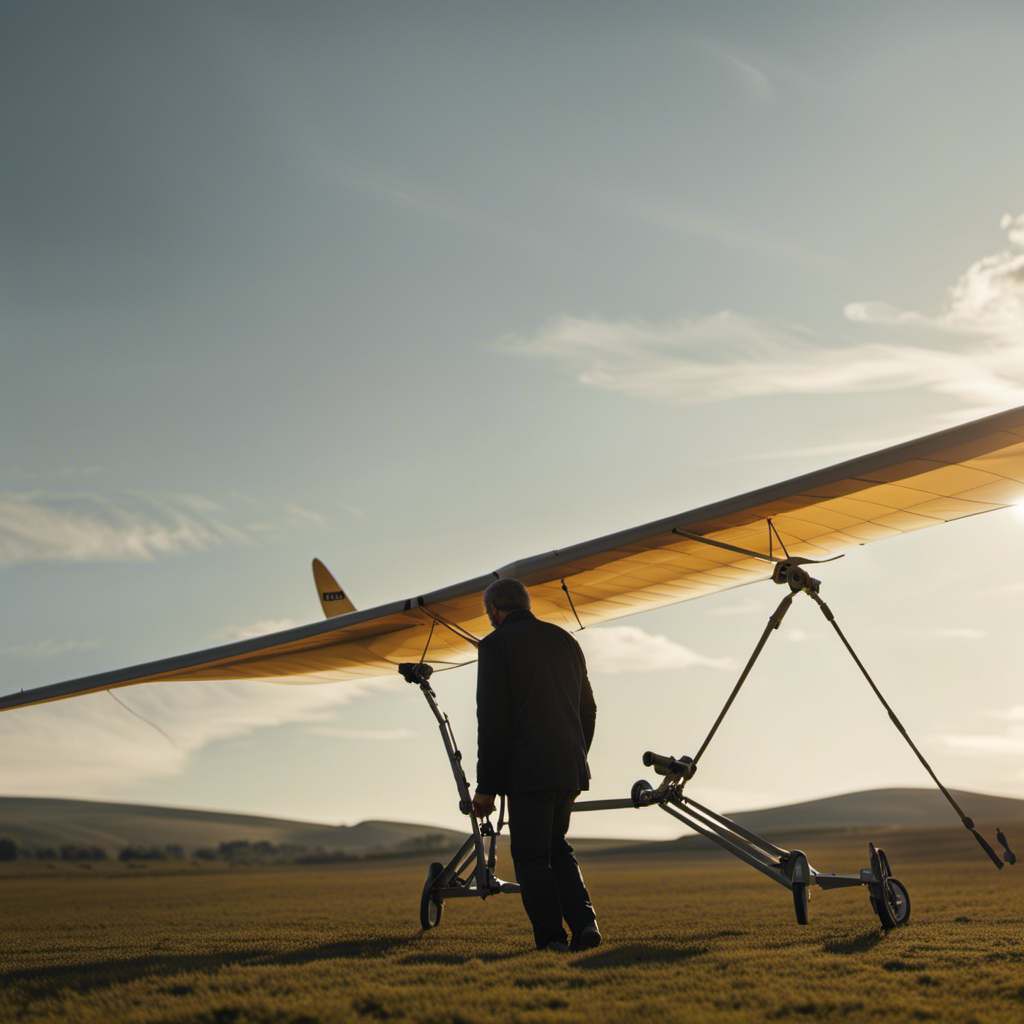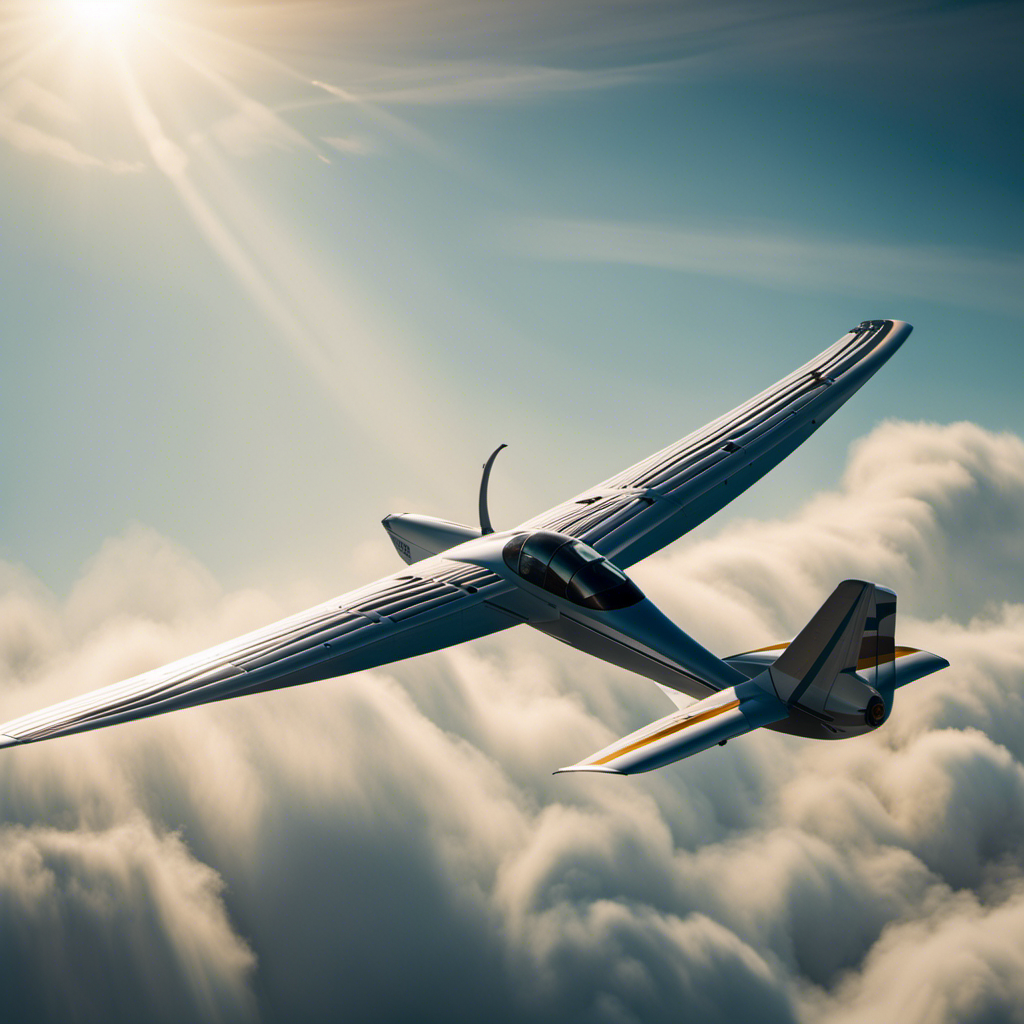As a passionate fan of elastic launch gliders, I have come to appreciate the precision and skill required for a flawless launch. It is a craft that combines careful planning, strategic decisions, and a thorough understanding of aerodynamics.
In this article, we will delve into the intricacies of launching an elastic launch glider, exploring the steps and techniques that will enable you to achieve maximum distance and flight stability.
So, let’s dive in and discover the secrets to launching these remarkable flying machines.
Key Takeaways
- Small adjustments to control surfaces ensure desired flight characteristics.
- Proper launch technique enhances stability and climb.
- Practice and experiment to find the perfect balance.
- Analyze performance and areas for improvement.
Choose the Right Glider Model
When choosing the right glider model, it’s important to consider factors such as wing design and weight distribution.
The glider construction plays a crucial role in determining its performance. A well-built glider with sturdy materials and precise engineering will have better stability and durability.
The wing design is another critical aspect to consider. The shape and size of the wings affect the glider’s lift and control. A glider with wings that are too small may struggle to generate enough lift, while wings that are too large can lead to excessive drag.
Additionally, weight distribution is essential for achieving optimal flight. By distributing the weight evenly, the glider will maintain balance in the air, resulting in smoother and more controlled flights.
With these considerations in mind, the right glider model can greatly enhance the overall performance of your elastic launch glider.
Now, let’s move on to preparing the glider for launch.
Prepare the Glider for Launch
To prepare for launch, you’ll need to make sure your glider is properly set up. This involves making necessary modifications to optimize its performance and stability.
Begin by checking the balance of the glider. Ensure that the center of gravity is aligned with the recommended position.
Next, examine the wing configuration. Adjust the dihedral angle to enhance stability during flight. Additionally, inspect the control surfaces, such as the elevator and rudder, to ensure they are properly aligned and functioning smoothly.
Once your glider is modified, it’s important to master the proper launch techniques. Start by holding the glider securely, with your thumb and index finger gripping the fuselage. Then, swiftly and smoothly launch the glider using an upward motion, while simultaneously applying a small amount of forward force. This will generate the necessary initial momentum for a successful flight.
Now that your glider is prepared for launch, let’s move on to finding the ideal launch site.
Find the Ideal Launch Site
Once you’ve located a suitable spot, make sure the launch site is free of any obstacles or debris. Ensuring ideal launch conditions is crucial for a successful elastic launch glider flight. When scouting for potential launch sites, consider the following factors:
- Wind Direction: Choose a spot where the wind is blowing in the desired direction, aiding the glider’s trajectory.
- Open Space: Look for a location with ample open space to give the glider enough room to gain altitude and distance.
- Smooth Terrain: A smooth, flat surface will allow the glider to take off smoothly without any disruptions.
- Clear Sky: Avoid launching the glider near trees, buildings, or other objects that could interfere with its flight path.
- Accessibility: Opt for a site that is easily accessible, allowing for easy setup and retrieval of the glider.
By carefully considering these factors, you can find the ideal launch site for your elastic launch glider.
Now, let’s move on to determining the optimal launch angle for maximum distance and height.
Determine the Optimal Launch Angle
You’ll want to consider the angle that will give your glider the highest and farthest trajectory. To determine the optimal launch angle for your elastic launch glider, you can experiment with different launch methods and calculate the launch velocity.
Start by launching the glider at different angles, such as 10 degrees, 15 degrees, and 20 degrees. Measure the distance covered by the glider for each launch. Keep the launch velocity constant and record the results.
Plot the data on a graph to analyze the relationship between launch angle and distance traveled. By examining the graph, you can identify the launch angle that yields the highest and farthest trajectory.
Once you have determined the optimal angle, you can move on to the next step: holding the glider correctly.
Hold the Glider Correctly
Make sure you hold the glider correctly to ensure a successful launch. The correct grip and launch technique are crucial for achieving maximum flight distance and stability. Here are three key factors to consider:
-
Finger placement: Position your fingers on the glider’s wings, ensuring a firm but gentle grip. Placing your fingers too close to the fuselage can disrupt the glider’s balance, while gripping too tightly can impede its ability to glide smoothly.
-
Balance and stability: Hold the glider level, making sure it is not tilted or tilted nose-down. This will ensure that the glider maintains a steady flight trajectory and avoids any unwanted dips or dives.
-
Consistent release: When launching the glider, ensure a smooth and controlled release. A sudden or jerky release can lead to erratic flight patterns and reduce overall distance.
By holding the glider correctly, you set the stage for a successful launch and a thrilling flight experience.
Now, let’s move on to the next step: stretching the elastic bands.
Stretch the Elastic Bands
Stretching the elastic bands is an essential step in preparing the glider for launch. Proper glider maintenance and ensuring the correct tension of the elastic bands are crucial for a successful flight. To achieve optimal performance, it is important to understand the relationship between elastic band tension and the glider’s flight characteristics. By adjusting the tension, we can control the launch height, speed, and trajectory of the glider. The table below illustrates the impact of different elastic band tensions on the glider’s flight:
| Elastic Band Tension | Launch Height | Launch Speed | Trajectory |
|---|---|---|---|
| High | High | Low | Steep |
| Medium | Medium | Medium | Balanced |
| Low | Low | High | Shallow |
To release the glider smoothly, we must ensure that the elastic bands are stretched evenly and securely. This will provide a consistent and predictable launch, allowing the glider to soar through the air with stability and grace.
Release the Glider Smoothly
After stretching the elastic bands to their maximum potential, it is crucial to release the glider smoothly to ensure a successful launch. The smooth release is a critical step in the launch technique that requires precise control and coordination.
To achieve a smooth release, I position my index and middle finger on the glider’s nose, ready to let go at the optimal moment. As the tension in the elastic bands builds, I carefully gauge the glider’s stability, making sure it is pointing in the desired direction.
Then, with a gentle flick of my fingers, I release the glider with finesse, allowing it to soar through the air with minimal disturbance. The smooth release enhances the glider’s aerodynamic performance and increases its chances of achieving maximum distance and duration.
Now, let’s explore how to adjust for trim and stability without compromising the glider’s flight.
Adjust for Trim and Stability
To ensure optimal trim and stability, it’s important to make small adjustments to the glider’s control surfaces. Adjusting for weight distribution is crucial in achieving the desired flight characteristics.
By fine-tuning the elevator, ailerons, and rudder, you can optimize the glider’s performance.
Proper launch technique also plays a significant role in achieving a stable flight. A smooth and controlled release, along with the correct launch angle, can greatly affect the glider’s initial climb and overall stability.
It’s essential to practice and experiment with different adjustments and launch techniques to find the perfect balance for your glider. Through trial and error, you can refine your understanding of the glider’s behavior and make informed decisions to improve its trim and stability.
Practice and Experiment
When practicing and experimenting with different adjustments and techniques, you can gain valuable insights into improving your glider’s trim and stability. Here are three key practices to consider:
-
Practice techniques: Take the time to practice launching your glider using different techniques, such as varying the angle of release or adjusting the amount of force applied. This will help you understand how different techniques affect the glider’s flight path and stability.
-
Record data: Keep a record of each launch, noting the adjustments you made and the resulting flight characteristics. This data will allow you to analyze trends and patterns, helping you identify what adjustments work best for your glider.
-
Analyze and iterate: Use the data you’ve collected to analyze the performance of your glider. Look for areas where improvements can be made and experiment with different adjustments to fine-tune the trim and stability.
Enjoy the Flight and Learn from Each Launch
As I enjoy each flight, I take the opportunity to learn from every launch, gaining valuable insights along the way. Learning from mistakes is crucial in improving my elastic launch glider skills. By analyzing each launch, I can identify the factors that contributed to success or failure. Was it the angle of launch? The amount of tension in the elastic band? By pinpointing these variables, I can make adjustments and refine my technique.
It’s also important to share experiences with other enthusiasts. By discussing our launches and exchanging ideas, we can learn from each other’s successes and failures. This collective knowledge is invaluable in the pursuit of launching the perfect elastic launch glider.
Frequently Asked Questions
How do I calculate the optimal launch angle for my elastic launch glider?
To calculate the optimal launch angle for my elastic launch glider and optimize the launch height, I need to consider factors such as the glider’s aerodynamics, weight, and desired trajectory. By analyzing these variables, I can determine the most efficient launch angle.
What are some common mistakes to avoid while holding the glider for launch?
When holding the glider for launch, common mistakes include incorrect grip placement and excessive force applied. These errors can lead to a suboptimal launch angle, affecting the glider’s flight performance and reducing its overall effectiveness.
How can I adjust the glider’s trim and stability for better flight performance?
To improve flight performance, I adjust the glider’s trim, stability, and launch angle. By fine-tuning these factors, I can enhance the glider’s aerodynamics and ensure a smooth flight. Additionally, utilizing advanced techniques and following expert tips can further optimize its performance.
Are there any specific safety precautions to keep in mind while launching an elastic glider?
Proper hand placement is crucial for a safe elastic glider launch. Just like a pilot gripping a control stick, I position my hands precisely to ensure stability and control. Additionally, I carefully assess wind conditions to avoid unsafe launches.
What are some advanced techniques or tips for improving the flight performance of an elastic launch glider?
To improve the flight performance of an elastic launch glider, design considerations such as wing shape, weight distribution, and stability are crucial. Additionally, mastering launching techniques, including the angle and force applied, can greatly enhance the glider’s performance.
Conclusion
In conclusion, launching an elastic launch glider successfully requires careful preparation and practice.
By choosing the right glider model and preparing it properly, finding the ideal launch site, determining the optimal launch angle, and holding and releasing the glider correctly, you can maximize your chances of a smooth launch.
Adjusting for trim and stability is also crucial for a successful flight. Some may argue that launching a glider is a simple task, but it actually requires precision and analytical thinking to achieve optimal results.
With a heart that soars as high as the skies, Aria, affectionately known as “Skylark,” is the driving force behind Soaring Skyways. Her journey into the gliding world began as a young dreamer gazing up at the soaring birds, yearning to experience the weightlessness and freedom they embodied. With years of experience both in the cockpit and behind the scenes, Aria’s commitment to the gliding community is unwavering.










